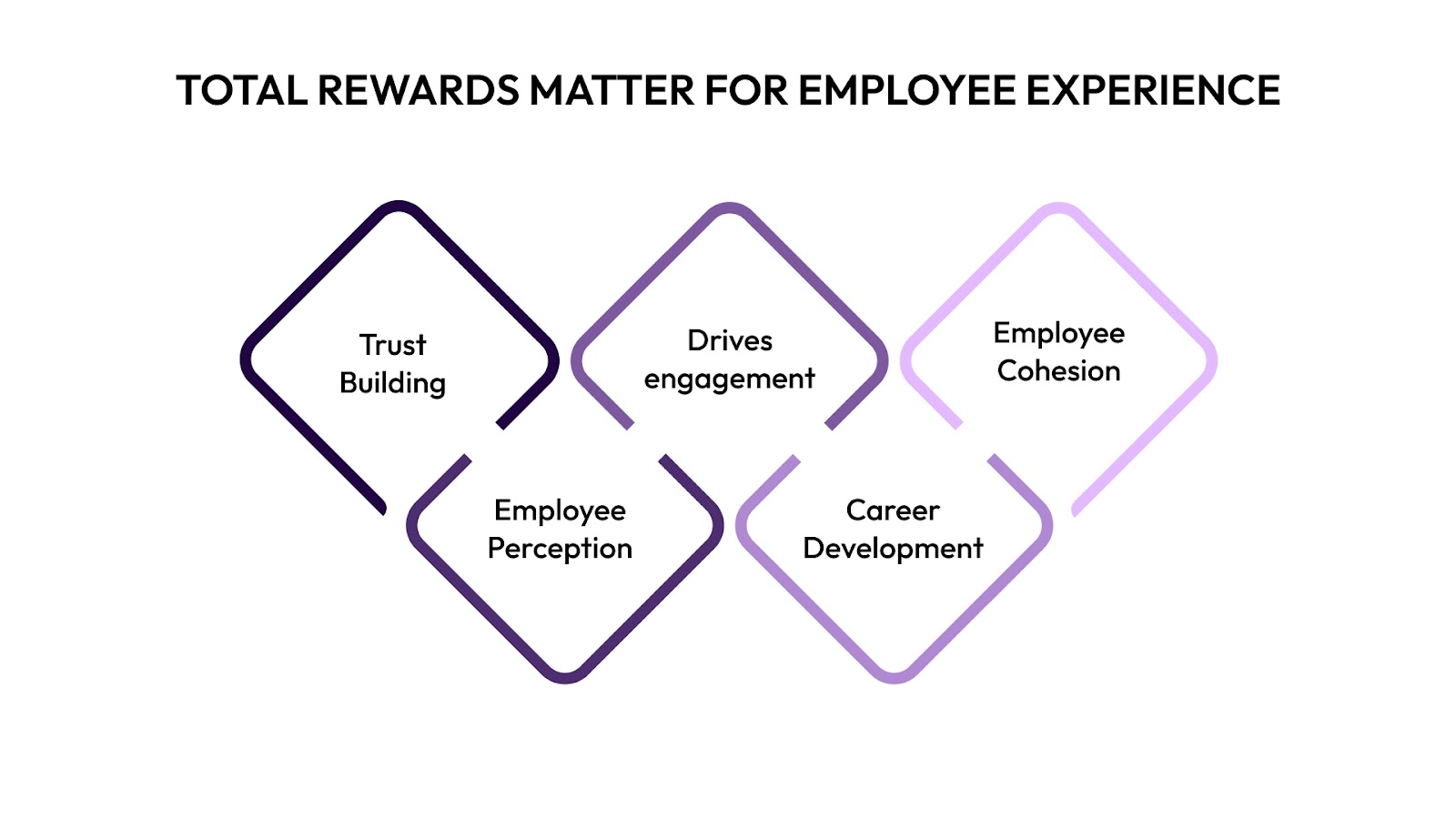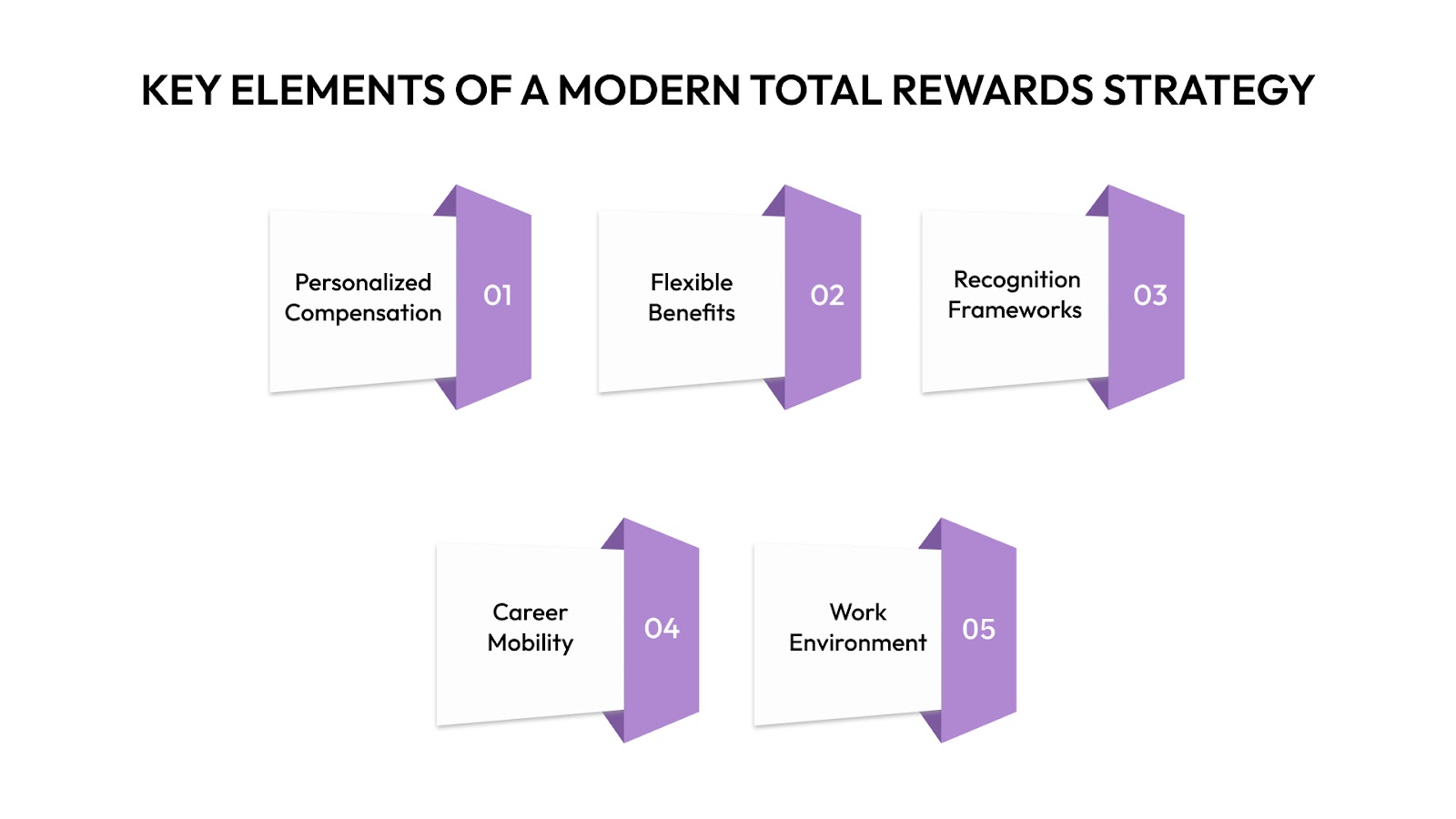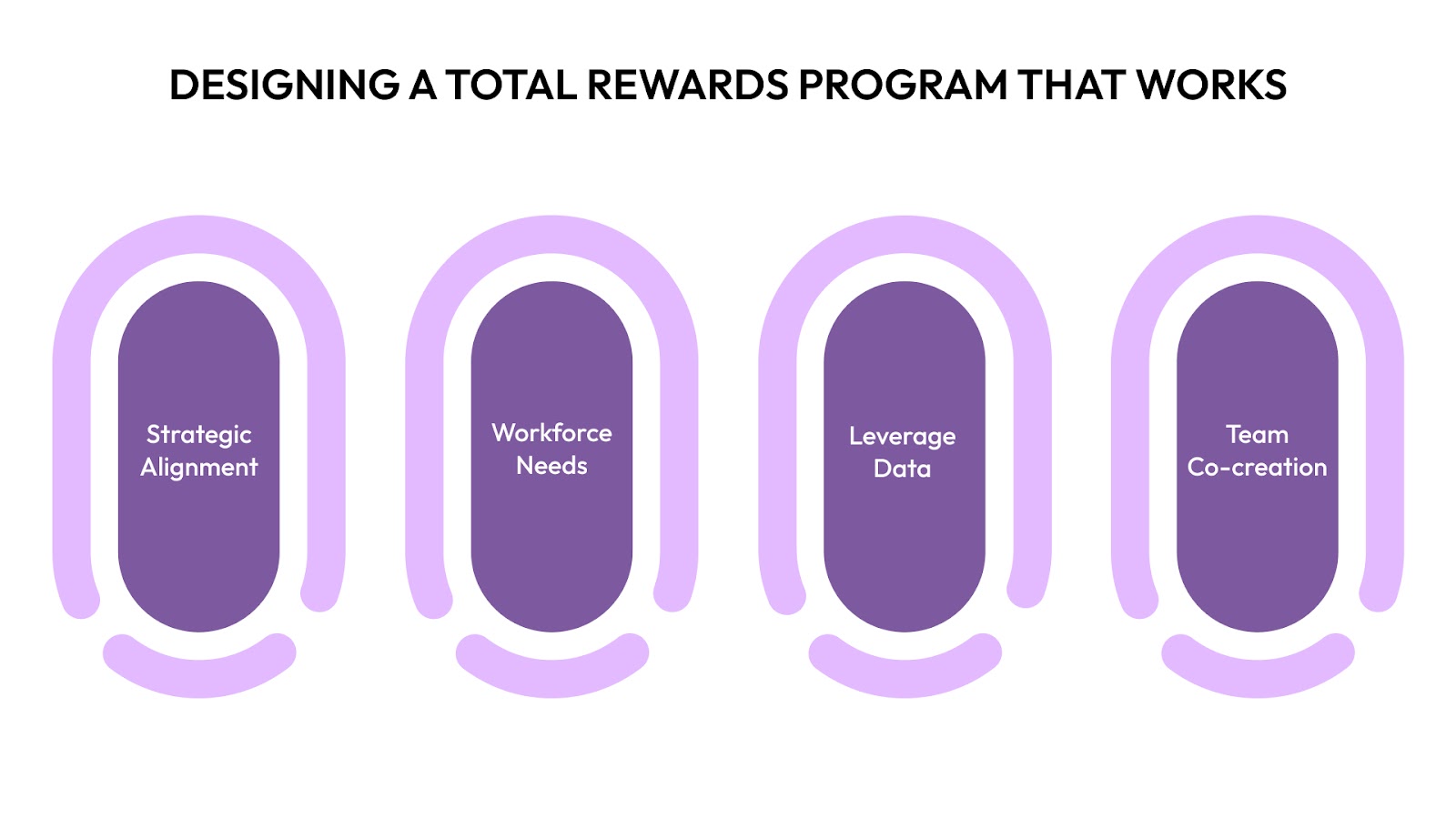Enhancing Employee Experience Through Total Rewards Strategies
Boost employee loyalty with total rewards strategies. Offer competitive pay, modern benefits, and growth opportunities. Enhance experience today!

For fast-growing companies in the USA, a competitive salary alone no longer guarantees retention or loyalty. Mid-sized organizations in sectors like SaaS, fintech, e-commerce, and professional services are scaling headcount rapidly while managing remote teams, rising attrition, and lean HR bandwidth.
Most of these companies operate with HR teams of 1 to 10 members and total workforce sizes ranging from 50 to 5,000 employees. For CFOs, CPOs, HR Business Partners, and Recruiting Managers, the challenge lies in maintaining fairness, structure, and performance alignment during this growth.
That is where Total Rewards strategies come in. Unlike traditional compensation models that focus only on base pay, Total Rewards connects salary, benefits, recognition, learning, and flexibility into a single employee experience. It is not just about retention. It is about building trust, increasing transparency, and enabling scalable workforce planning.
This blog explores how modern organizations can use Total Rewards as a lever to improve engagement, strengthen their employer brand, and bring more predictability into workforce costs.
TL;DR (Key Takeaways)
- Total Rewards goes beyond salary to include benefits, recognition, growth opportunities, and work-life flexibility in one unified experience
- Incentives should be segmented by team needs; what motivates sales may not matter to engineering or support
- Continuous employee feedback through pulse surveys or polls helps shape rewards that actually get used
- Peer recognition and value-based appreciation can create deeper engagement than one-time bonuses
- Flexible policies, mental health support, and remote work options improve retention by showing trust and care
What Is Total Rewards?

Total Rewards is a modern framework for employee experience. It brings together everything that makes a job worthwhile, not just the paycheck.
Instead of focusing only on compensation, it connects financial and non-financial rewards to create a consistent and motivating work environment.
The five core pillars of Total Rewards are:
- Compensation: Includes base salary, variable pay, incentives, and equity
- Benefits: Covers health insurance, paid time off, wellness programs, and retirement plans
- Recognition: Ranges from peer shoutouts and thank-you notes to structured awards and milestone celebrations
- Career Development: Focuses on upskilling, internal mobility, mentorship, and clear promotion paths
- Work-Life Environment: Reflects flexibility, autonomy, psychological safety, and alignment with purpose
The difference between traditional rewards and Total Rewards is focus. Older models center on pay. Total Rewards treats every part of the employee journey as a lever for retention and performance.
Why Total Rewards Matter for Employee Experience

Total Rewards plays a critical role in shaping how employees feel about their work, their employer, and their future within the company. Here’s why it matters:
- Builds trust through a strong psychological contract: Employees value more than just salary. They want to feel respected, supported, and fairly treated across all aspects of work.
- Influences how employees perceive fairness and appreciation: Transparent pay structures, regular recognition, and consistent benefits show that the organization values its people.
- Drives engagement and retention: According to Gallup, employees who feel their employer cares about their well-being are 69% less likely to look for new jobs.
- Supports long-term career growth: Career development programs and upskilling opportunities help employees see a future within the company.
- Creates a cohesive employee experience: When compensation, benefits, recognition, and work-life support are aligned, it leads to higher job satisfaction and stronger performance.
Key Elements of a Modern Total Rewards Strategy

A well-rounded Total Rewards strategy goes beyond base salary. It addresses what motivates today’s diverse workforce and aligns each component with business goals and employee expectations.
Personalized Compensation Models
- Transparent salary bands with room for growth
- Equity modeling for long-term value
- Performance-based bonuses tied to team or business outcomes
CandorIQ helps HR and Finance teams forecast comp decisions, align pay with performance, and model budgets without spreadsheets.
Flexible Benefits
- Modular health plans, wellness stipends, fertility and mental health support
- Caregiving leave, remote work reimbursements, and DEI-aligned policies
Recognition Frameworks
- Peer-to-peer shoutouts on platforms like Slack or MS Teams
- Spot bonuses triggered by achievements
- Recognition tied directly to core values or KPIs
Learning and Career Mobility
- Learning budgets for courses and certifications
- Mentorship programs and lateral movement support
- Internal career pathing aligned with skills, not just titles
Culture and Work Environment
- Remote-first work options with geo-adjusted pay
- Psychological safety and feedback loops
- Company rituals that scale with growth
Platform like CandorIQ supports globally distributed companies in maintaining fair and consistent compensation policies across markets.
Designing a Total Rewards Program That Works

You don’t need dozens of perks. You need a rewards mix that reflects employee needs and aligns with business realities. Here’s how to design it:
Start with Strategic Alignment
Reward structures should reinforce what your company values most whether that’s innovation, cross-functional collaboration, or speed.
Segment Based on Workforce Needs
Different teams want different things.

Leverage Data to Prioritize What Matters
Let teams vote on new benefits, pilot small programs, or co-create recognition rules. Participation boosts buy-in.
Co-Create with Employees
Track benefit usage, recognition frequency, and satisfaction scores. Look for patterns, not assumptions. With CandorIQ, HR and Finance teams gain real-time analytics on how rewards influence performance, diversity, and retention.
A well-designed rewards program does not have to be the most expensive. It needs to be the most relevant.
Common Mistakes to Avoid

Even the most well-intentioned Total Rewards programs can fall flat if they miss the mark in these key areas:
Applying the Same Strategy to Everyone
Over-standardizing rewards can alienate different segments of the workforce. A single package for sales, engineering, and support roles often results in mismatches. For instance, sales teams may prioritize performance-based incentives, while engineering teams may care more about remote flexibility and skill-building opportunities.
Treating Compensation as the Only Lever
Salary alone doesn't create a great employee experience. If rewards are not paired with meaningful recognition, growth opportunities, and support systems, they won’t move the needle on engagement. Employees may feel well-paid but still disengaged.
Leaving Managers Out of the Loop
Managers are often the bridge between HR policy and employee perception. If they are unclear about how to talk about benefits, growth paths, or recognition frameworks, employees are likely to remain unaware or skeptical of the offerings.
Not Measuring What Matters
Skipping metrics like perceived fairness, benefit utilization, or internal mobility trends limits your ability to improve. Without data, you're just guessing whether the program is working. Use feedback loops and performance data to validate and evolve your strategy.
How Platforms Like CandorIQ Can Help
CandorIQ is built for high-growth companies scaling headcount across regions while managing lean HR and Finance teams. It replaces spreadsheets and guesswork with one unified platform for everything compensation-related. Modern Total Rewards programs require more than spreadsheets and scattered tools.
- Unified View of Compensation and Rewards: CandorIQ brings together base salary, bonuses, equity, and recognition data in one centralized dashboard. This ensures that every decision is backed by real-time visibility into total employee value.
- Scenario Modeling for Smarter Planning: Whether you're rolling out new equity plans or revisiting merit cycles, CandorIQ’s modeling tools allow you to compare the impact of different reward strategies before making changes. You can forecast costs, simulate outcomes, and stay within budget while staying competitive.
- Built-in Analytics to Measure Impact: Understand how your rewards are influencing engagement, retention, and pay equity. CandorIQ helps you track trends over time and adjust strategies based on what actually drives outcomes.
- Cross-Functional Alignment: With customizable access controls, HR, Finance, and leadership teams can collaborate on decisions using a shared language and consistent data. This reduces friction and improves execution across departments.
Whether you're managing 50 or 5,000 employees, CandorIQ brings structure, speed, and clarity to Total Rewards planning.
Wrapping Up
A well-designed Total Rewards strategy goes beyond salary. It’s a holistic approach that shows employees they’re valued, through meaningful benefits, clear growth paths, real-time recognition, and a supportive work culture. When organizations align these elements with both business goals and employee expectations, they don’t just improve retention. They build trust, engagement, and long-term loyalty.
But getting it right requires clarity, data, and the ability to adapt quickly.
For fast-scaling teams, especially those managing remote operations and limited HR bandwidth, platforms like CandorIQ make it easier to get Total Rewards right.
Ready to replace disconnected tools with a unified system? Book a demo to see how CandorIQ can bring structure, equity, and visibility to your rewards strategy.
FAQ
1. What does a Total Rewards strategy include?
It combines base pay, benefits, learning and development, recognition, and a supportive work culture to create a complete employee experience.
2. How is Total Rewards different from traditional compensation?
Traditional models focus mostly on salary. Total Rewards includes the emotional, developmental, and cultural elements that keep people engaged.
3. Who should implement a Total Rewards strategy?
Fast-growing organizations, especially those with lean HR and finance teams, distributed workforces, and high attrition risk.
4. What tools or data do companies use to improve their rewards strategy?
Surveys, engagement platforms, and internal HR data help track benefit usage, performance outcomes, and fairness across the workforce.
5. How can companies support different employee preferences?
By offering modular benefits, role-specific incentives, and co-created recognition programs that reflect diverse needs and work styles.
6. Why is manager involvement important in rewards?
Managers are the link between HR strategy and employee experience. They need clarity and training to communicate the value of rewards programs effectively.


